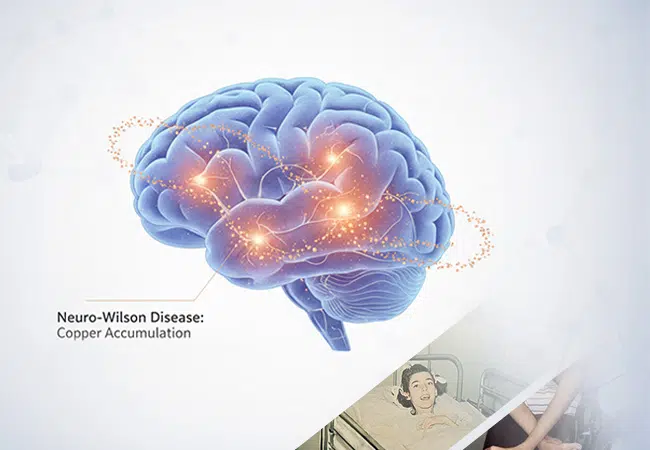What Is Wilson’s Disease?
Wilson’s disease is a rare genetic disorder. It is caused by mutations in the ATP7B gene, which regulates copper transport in the body. Excess copper is typically filtered by the liver and expelled as bile. This process is disrupted in Wilson’s disease, where copper builds up in important organs such as the liver, brain, and eyes, eventually causing organ damage.
The disease can go years without being noticed because copper accumulates silently. It may cause severe liver disease, movement problems, and mental health issues if not identified and treated quickly.
Why the Brain Is Affected in Wilson’s Disease
Communication between neurons is hampered when copper accumulates in the brain area known as the basal ganglia, which is in charge of motor control. This eventually results in emotional instability, dystonia, speech issues, tremors, and slowness.
These neurological symptoms of Wilson’s disease can mimic those of psychiatric disorders, Parkinson’s disease, or dystonia, which frequently delays diagnosis. Early detection of these symptoms is essential for safeguarding brain function and avoiding permanent harm.
Early Signs and Symptoms of Wilson’s Disease:
Depending on which organ is impacted first, Wilson’s disease symptoms can manifest at any time between the ages of 5 and 35. The following are the most typical early indicators:
- Liver-Related Symptoms: Jaundice (yellowing of the skin and eyes), exhaustion, nausea, and abdominal pain. Before experiencing neurological symptoms, some patients develop cirrhosis or liver failure.
- Behavioral and Psychiatric Changes: Early onset is frequently associated with irritability, depression, anxiety, mood swings, difficulty concentrating, and deteriorating performance at work or school. Occasionally, these affective symptoms are mistakenly identified as primary mental illnesses.
- Physical and Visual Clues: Hand tremors, muscle stiffness, or inexplicable weight loss could appear. The Kayser-Fleischer ring, which is a golden-brown copper deposit in the cornea that can be seen during a slit-lamp eye exam, is a distinguishing diagnostic characteristic.
Major Neurological Symptoms of Wilson’s Disease:
Movement Disorders: Tremor, which can range from tiny hand shakes to more extensive “wing-beating” motions, is frequently the first neurological symptom. Additionally, many patients encounter:
- Muscle stiffness
- Slowness of movement (bradykinesia)
- Postural imbalance
- Difficulty starting motion
These resemble Parkinson’s disease, but they affect younger people.
- Dystonia and Involuntary Muscle Contractions: Too much copper impairs muscle coordination, resulting in excruciating twisting motions of the face, limbs, or neck muscles. Writing, eating, and walking are examples of everyday activities that may be impacted.
- Speech and Swallowing Difficulties: Patients who experience brainstem control impairments may experience low voice volume, slurred speech (dysarthria), and difficulty swallowing (dysphagia), all of which raise the risk of aspiration.
- Coordination and Balance Problems: Damage to the cerebellum causes unsteady gait, frequent falls, and lack of hand-eye coordination, making precise tasks challenging.
- Behavioral and Cognitive Changes: Wilson’s disease affects not just movement but also emotion, personality, and thought processes. Among the symptoms are:
- Lack of focus
- Depression or anxiety
- Sudden mood swings
- Social withdrawal
- Personality changes
These psychological and neurological characteristics work together to cause neurological Wilson’s disease.
Is Wilson’s Disease Rare?
Indeed. Wilson’s disease affects 1 in 30,000 to 40,000 people worldwide, but because its symptoms can overlap with those of other illnesses like hepatitis, liver failure, or mental illness, it may go undiagnosed.
The disease is inherited in an autosomal recessive pattern, which means that for a child to get it, both parents must have one faulty copy of the ATP7B gene. The effects are equally felt by men and women.
Why Early Detection Matters:
Liver scarring and irreversible brain damage can result from a delayed diagnosis. Complications can be avoided and quality of life can be greatly enhanced by early detection using blood tests, 24-hour urine copper tests, slit-lamp examination, and genetic screening.
Since early treatment can totally stop the progression of the disease, testing siblings and first-degree relatives is also advised.
Treatment and Management of Wilson’s Disease:
- Wilson’s disease can be treated with lifelong treatment that removes copper and prevents its further accumulation.
- Chelating Agents: Chelation therapy is the mainstay of treatment. Therapeutic drugs like Trientine 250 mg (Triokris) or D-Penicillamine bind to excess copper and help eliminate it safely through urine.
- Maintenance Therapy: To maintain safe copper levels following initial copper removal, patients continue using zinc therapy or low-dose chelators.
- Dietary Management: It is recommended to stay away from foods high in copper, such as mushrooms, shellfish, nuts, and chocolate. Liver function tests and neurological evaluations must be performed on a regular basis.
Generic Trientine 250 mg (Triokris™) is Available in India:
Ikris Pharma Network launched Trientine 250 mg capsules (Triokris™) to make treatment more affordable and accessible. The product is created and produced in a US FDA-approved facility that complies with international quality standards.
For patients who are unable to tolerate D-Penicillamine, we offers dependable access to trientine, an efficient chelating agent for Wilson’s disease.
By supporting patients, hospitals, doctors, and NGOs, Ikris ensures a timely, compliant, and traceable supply of rare-disease medicines.
What are the neurological manifestations of Wilson’s disease?
Neurological manifestations of Wilson’s disease include tremors, dystonia, muscle stiffness, slurred speech, and coordination problems. These symptoms result from copper accumulation in the brain, particularly in areas controlling movement and cognition.
What are the brain symptoms of Wilson’s disease?
Wilson’s disease brain symptoms often resemble Parkinson’s disease. Patients may experience shaking of the hands, involuntary muscle movements, difficulty speaking or swallowing, loss of balance, and changes in mood or behavior.
How is Wilson’s disease treated in India?
Wilson’s disease treatment in India typically involves chelating agents such as Trientine or Penicillamine to remove excess copper from the body. Supportive care may include zinc therapy, liver monitoring, and regular follow-up with hepatologists or neurologists.
What are Trientine capsules used for in Wilson’s disease?
Trientine capsules are prescribed for the treatment of Wilson’s disease. Trientine capsules for Wilson’s disease work by binding to excess copper in the body and helping to eliminate it through urine. This prevents further damage to the liver, brain, and other vital organs.
Is Trientine available in India for Wilson’s disease patients?
Yes. Trientine in India is available under the brand Triokris™, developed by Ikris Pharma Network. Manufactured in a US FDA-approved facility, this medicine ensures global quality and safety standards for managing Wilson’s disease effectively.
How can I buy Trientine 250 mg (Triokris) in India?
Patients, hospitals, and importers can buy Trientine 250 mg in India through Ikris Pharma Network, a trusted manufacturer and supplier. For more details or to access Trientine capsules in India, contact Indian Pharma Network (IPN) via call: +91 85272 73611, WhatsApp: +91 98104 69557, dial Toll-Free: 1800 1200 365.






